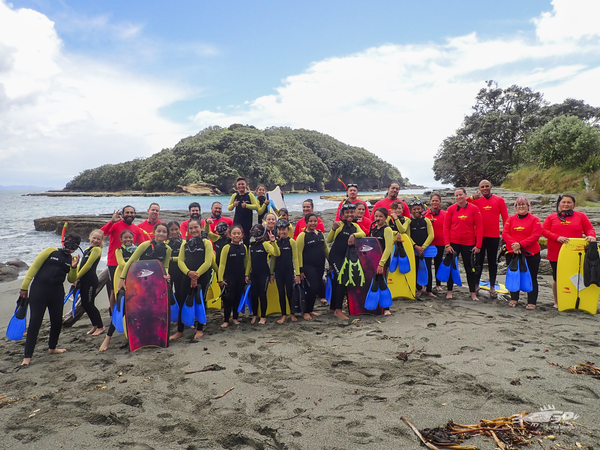
If you are not yet signed up for a programme you can express your interest here.
The key ways EMR supports the curriculum is via Science (Living World - ecology and evolution), Social Science (cultural values of the marine environment, community response to challenges etc) and Health and PE (snorkelling) .We are committed to delivering safe snorkelling excursions and have robust health and safety documentation to match. We provide ALL the snorkel equipment required. We are adventure activity safety audit certified (AAO 534).
Download our educators manual here Download all our resources here
Step 1: Planning your programme
- Once you have expressed interest for a programme your EMR region will contact you - either to organise a planning meeting or requesting more information to apply for funding.
- If you have been sucessful in getting a programme EMR will organise a planning meeting to set dates and to sign the schools agreement
- Once signed your dates are locked in - your EMR coordinator will send you a finalised version of the Schools Initerary which has the timeline for your programme.
- EMR has a template permission form - your school can amend this to suit. We don't need signed forms from every student - just a spreadsheet of all the student's names, medical conditions and emergency contacts. Health and safety forms are found here
- If you would like a combine marine and freshwater approach to your programme we have also developed a Mountains to Sea version of our programme, that partners with our sister organisation Whitebait Connection. If you would like to know more about the Mountains to Sea programme check out the programme outline here.
Step 2: Get the resources to integrate into your curriculum before the programme starts
- Download the EMR educator's manual

![]() EMR_Educators_Manual.pdf7.03 MB
EMR_Educators_Manual.pdf7.03 MB
Download and print the EMR or MTS Learning Journal for the students participating in the programme - ready for the start of the programme. We recommend students naming the journals to be held by the teacher
 EMR_learning_journal_2020_-_PDF_version_ready_to_print_as_booklet.pdf5.35 MB
EMR_learning_journal_2020_-_PDF_version_ready_to_print_as_booklet.pdf5.35 MB EMR_learning_journal_2020_-_PDF_version.pdf983.71 KB
EMR_learning_journal_2020_-_PDF_version.pdf983.71 KB Mountains_to_Sea_Learning_journal.pdf
Mountains_to_Sea_Learning_journal.pdf
- Check out these optional lesson plans for teachers - see the cache at the bottom of this page for all marine resources
- These organisations have helpful resources and programmes that mesh well with EMR
Step 3: Start your programme - please note that the programme structure varies for each region
Classroom session
An EMR coordinator will come into the classroom and present the introduction powerpoint. They may also have a treasure box of marine critters to share or play interactive games.
Local investigation
Either snorkelling or intertidal activities dependent on region
- Local snorkel led by EMR
- Marine Metre Squared surveys led by EMR - create a login on the website to download ID charts and resources.
- Para Kore ki Tāmaki - Waste free initiatives through a Te Ao Māori lens (Auckland only)
- Clean up of local area - EMR to provide bags and gloves from Sustainable Coastlines
- Whitebait Connection stream survey
Facilitated Action Workshops (only in some regions)
An EMR coordinator will come into class to run a workshop with the students to brainstorm issues in their local area and to start planning their action projects.
Pool session
Either held in your school pool or a local public pool. The school needs to book 2 side lanes and have a teacher poolside.
Marine Reserve/ Rāhui Snorkel
It's time to go snorkelling! Your coordinator will have sent you the site specific RAMs for your snorkel site and any other site specific information that might be important. You may need to refer to our health and safety health and safety page for your management
Action project marking
An EMR crew member will come back into the classroom to mark and document all the actions from the students. Some schools create a science fair style expo in the school hall. While others nominate the top projects to present to the class/year group. The coordinator will also get evaluations at this time - the Student & Staff Evaluations can be found here.
Our marking criteria
Step 4: Wrap up your programme
Your EMR coordinator will get both students and teachers to complete an evaluation via Google Forms. This helps us secure funding in the future.
They will share the images from the programme with you on Facebook and Google Pictures.
Success Criteria (Learning Outcomes)
Students will be able to:
1. Give at least 3 examples of New Zealand marine biodiversity & explain what a marine reserve is.
2. Explain & use snorkel equipment
3. Describe their local marine area and what lives in it.
4. Identify & classify some of the marine creatures they see and local threats
5. Make comparisons between a marine reserve and unprotected marine area.
Base their opinions about the value of marine reserves on their personal experiences and learning throughout EMR
6. Take action in their community – become Kaitiaki!
The EMR key learning concepts are:
The interdependence of living things in the marine environment.
The impact people have had, and can have on the marine environment.
The significance of marine reserves for protecting and enhancing marine biodiversity.
The importance of working together as local communities, including the ethic of Kaitiakitanga (stewardship).
